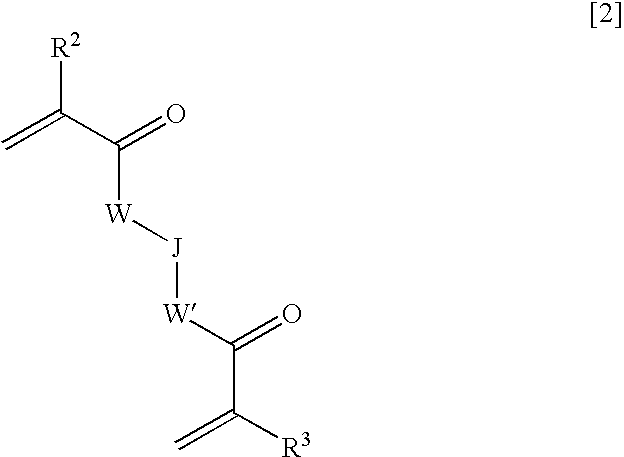Ophthalmic and otorhinolaryngological device materials containing an alkylphenol ethoxylate
- Summary
- Abstract
- Description
- Claims
- Application Information
AI Technical Summary
Benefits of technology
Problems solved by technology
Method used
Image
Examples
example 1
[0089]TritonX15-MA. 51.2 g (176 mmol based on equivalent weight=291) of Triton™ X-15 (Dow / Union Carbide) and 20 mg MEHQ (Aldrich, Milwaukee, Wis.) were dissolved in 300 ml anhydrous THF (Aldrich) in a 1 liter round bottom flask equipped with magnetic stirrer and nitrogen inlet. 27.6 g (178 mmol) of 2-isocyanatoethyl methacrylate (IEMA) (Aldrich) and 20 mg stannous octoate (Aldrich) were added and the reaction mixture was heated to 60° C. for 20 hours. The solvent was removed via rotary evaporation and the resulting liquid was further dried under vacuum (˜0.1 mm Hg) for 40 hours.
example 2
[0090]TritX35-MA. The reaction was carried out as in Example 1 using 53.6 g (169 mmol based on equivalent weight=317) of Triton™ X-35 (Dow / Union Carbide) and 20 mg MEHQ (Aldrich, Milwaukee, Wis.) and 24.3 g (157 mmol) of 2-isocyanatoethyl methacrylate (IEMA) (Aldrich) resulting in a liquid which was further dried under vacuum (˜0.1 mm Hg) for 40 hours.
example 3
[0091]TritX102-MA. The reaction was carried out as in Example 1 using 49.5 g (66.9 mmol based on equivalent weight=740) of Triton™ X-102 (Dow / Union Carbide) and 11.3 g (72.8 mmol) of 2-isocyanatoethyl methacrylate (IEMA) (Aldrich) resulting in a liquid which was further dried under vacuum (˜0.1 mm Hg) for 40 hours.
PUM
| Property | Measurement | Unit |
|---|---|---|
| Fraction | aaaaa | aaaaa |
| Fraction | aaaaa | aaaaa |
| Fraction | aaaaa | aaaaa |
Abstract
Description
Claims
Application Information
 Login to View More
Login to View More - Generate Ideas
- Intellectual Property
- Life Sciences
- Materials
- Tech Scout
- Unparalleled Data Quality
- Higher Quality Content
- 60% Fewer Hallucinations
Browse by: Latest US Patents, China's latest patents, Technical Efficacy Thesaurus, Application Domain, Technology Topic, Popular Technical Reports.
© 2025 PatSnap. All rights reserved.Legal|Privacy policy|Modern Slavery Act Transparency Statement|Sitemap|About US| Contact US: help@patsnap.com



